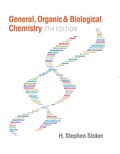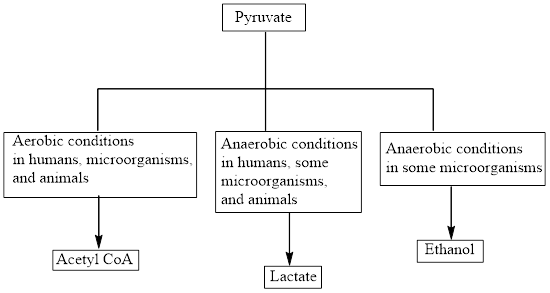
EBK GENERAL, ORGANIC, AND BIOLOGICAL CH
7th Edition
ISBN: 8220100853180
Author: STOKER
Publisher: CENGAGE L
expand_more
expand_more
format_list_bulleted
Concept explainers
Question
Chapter 24, Problem 24.39EP
Interpretation Introduction
Interpretation: To identify the chemical purpose for the lactate fermentation.
Concept introduction: Pyruvate is the end product in the glycolysis. The glycolysis pathway takes place under anaerobic conditions. Aerobic reactions need oxygen while anaerobic reactions don’t need oxygen.
The production of the fate of pyruvate varies with the nature of the organism and the cellular conditions. The three common fates of pyruvate are as follows:

Expert Solution & Answer
Want to see the full answer?
Check out a sample textbook solution
Students have asked these similar questions
What is the missing reactant in this organic reaction?
OH
H
+ R
Δ
CH3-CH2-CH-CH3
O
CH3
CH3-CH2-C-O-CH-CH2-CH3 + H2O
Specifically, in the drawing area below draw the condensed structure of R.
If there is more than one reasonable answer, you can draw any one of them. If there is no reasonable answer, check the No answe
box under the drawing area.
Explanation
Check
Click anywhere to draw the first
atom of your structure.
C
O2025 McGraw Hill LLC. All Rights Reserved. Terms of Use | Privacy Cer
Predict the product of this organic reaction:
CH3
NH2
Δ
CH3-CH-CH3 + HO-C-CH2-N-CH3
P+H₂O
Specifically, in the drawing area below draw the condensed structure of P.
If there is no reasonable possibility for P, check the No answer box under the drawing area.
Explanation
Check
Click anywhere to draw the first
atom of your structure.
X
In the scope of the SCH4U course, please thoroughly go through the second question
Chapter 24 Solutions
EBK GENERAL, ORGANIC, AND BIOLOGICAL CH
Ch. 24.1 - The primary site within the human body where...Ch. 24.1 - What is the first site within the human body where...Ch. 24.1 - What effect does gastric juice in the stomach have...Ch. 24.1 - Prob. 4QQCh. 24.1 - Which of the following substances is needed for...Ch. 24.2 - Prob. 1QQCh. 24.2 - Prob. 2QQCh. 24.2 - Prob. 3QQCh. 24.2 - Prob. 4QQCh. 24.2 - Prob. 5QQ
Ch. 24.2 - Prob. 6QQCh. 24.2 - Prob. 7QQCh. 24.3 - Prob. 1QQCh. 24.3 - Prob. 2QQCh. 24.3 - Prob. 3QQCh. 24.3 - Prob. 4QQCh. 24.3 - Accumulation of which of the following substances...Ch. 24.4 - Prob. 1QQCh. 24.4 - The net yield of ATP for the complete oxidation of...Ch. 24.4 - Prob. 3QQCh. 24.5 - Prob. 1QQCh. 24.5 - Prob. 2QQCh. 24.5 - Prob. 3QQCh. 24.6 - Prob. 1QQCh. 24.6 - Prob. 2QQCh. 24.6 - Prob. 3QQCh. 24.6 - Which of the following statements about ATP...Ch. 24.6 - Prob. 5QQCh. 24.7 - Prob. 1QQCh. 24.7 - Prob. 2QQCh. 24.8 - Prob. 1QQCh. 24.8 - Prob. 2QQCh. 24.8 - Prob. 3QQCh. 24.9 - Which of the following hormones promotes the...Ch. 24.9 - Which of the following pairs of hormones increases...Ch. 24.10 - Prob. 1QQCh. 24.10 - Prob. 2QQCh. 24.10 - Prob. 3QQCh. 24 - Where does carbohydrate digestion begin in the...Ch. 24 - Very little digestion of carbohydrates occurs in...Ch. 24 - Prob. 24.3EPCh. 24 - Prob. 24.4EPCh. 24 - Prob. 24.5EPCh. 24 - Prob. 24.6EPCh. 24 - Prob. 24.7EPCh. 24 - Prob. 24.8EPCh. 24 - Prob. 24.9EPCh. 24 - Prob. 24.10EPCh. 24 - Prob. 24.11EPCh. 24 - Prob. 24.12EPCh. 24 - Prob. 24.13EPCh. 24 - Prob. 24.14EPCh. 24 - Prob. 24.15EPCh. 24 - Prob. 24.16EPCh. 24 - Prob. 24.17EPCh. 24 - Prob. 24.18EPCh. 24 - Prob. 24.19EPCh. 24 - Prob. 24.20EPCh. 24 - Prob. 24.21EPCh. 24 - Prob. 24.22EPCh. 24 - Prob. 24.23EPCh. 24 - Prob. 24.24EPCh. 24 - Prob. 24.25EPCh. 24 - Prob. 24.26EPCh. 24 - Prob. 24.27EPCh. 24 - Prob. 24.28EPCh. 24 - Prob. 24.29EPCh. 24 - Prob. 24.30EPCh. 24 - Prob. 24.31EPCh. 24 - Prob. 24.32EPCh. 24 - Prob. 24.33EPCh. 24 - Prob. 24.34EPCh. 24 - Prob. 24.35EPCh. 24 - Prob. 24.36EPCh. 24 - Prob. 24.37EPCh. 24 - Prob. 24.38EPCh. 24 - Prob. 24.39EPCh. 24 - Prob. 24.40EPCh. 24 - Prob. 24.41EPCh. 24 - Prob. 24.42EPCh. 24 - Prob. 24.43EPCh. 24 - Prob. 24.44EPCh. 24 - Prob. 24.45EPCh. 24 - Prob. 24.46EPCh. 24 - Prob. 24.47EPCh. 24 - Prob. 24.48EPCh. 24 - Prob. 24.49EPCh. 24 - Prob. 24.50EPCh. 24 - Prob. 24.51EPCh. 24 - Prob. 24.52EPCh. 24 - Prob. 24.53EPCh. 24 - Prob. 24.54EPCh. 24 - Prob. 24.55EPCh. 24 - Prob. 24.56EPCh. 24 - Prob. 24.57EPCh. 24 - Prob. 24.58EPCh. 24 - Prob. 24.59EPCh. 24 - Prob. 24.60EPCh. 24 - Prob. 24.61EPCh. 24 - Prob. 24.62EPCh. 24 - Prob. 24.63EPCh. 24 - Prob. 24.64EPCh. 24 - Prob. 24.65EPCh. 24 - The liver, but not the brain or muscle cells, has...Ch. 24 - Prob. 24.67EPCh. 24 - Prob. 24.68EPCh. 24 - Prob. 24.69EPCh. 24 - Prob. 24.70EPCh. 24 - Prob. 24.71EPCh. 24 - Prob. 24.72EPCh. 24 - Prob. 24.73EPCh. 24 - Prob. 24.74EPCh. 24 - Prob. 24.75EPCh. 24 - Prob. 24.76EPCh. 24 - Prob. 24.77EPCh. 24 - Prob. 24.78EPCh. 24 - Prob. 24.79EPCh. 24 - Prob. 24.80EPCh. 24 - Prob. 24.81EPCh. 24 - Prob. 24.82EPCh. 24 - Prob. 24.83EPCh. 24 - Prob. 24.84EPCh. 24 - Prob. 24.85EPCh. 24 - Prob. 24.86EPCh. 24 - Prob. 24.87EPCh. 24 - Prob. 24.88EPCh. 24 - Prob. 24.89EPCh. 24 - Prob. 24.90EPCh. 24 - Prob. 24.91EPCh. 24 - Prob. 24.92EPCh. 24 - Prob. 24.93EPCh. 24 - Prob. 24.94EPCh. 24 - Prob. 24.95EPCh. 24 - Prob. 24.96EPCh. 24 - Prob. 24.97EPCh. 24 - Prob. 24.98EPCh. 24 - Prob. 24.99EPCh. 24 - Prob. 24.100EPCh. 24 - Prob. 24.101EPCh. 24 - Prob. 24.102EPCh. 24 - Prob. 24.103EPCh. 24 - Prob. 24.104EPCh. 24 - Prob. 24.105EPCh. 24 - Prob. 24.106EPCh. 24 - Prob. 24.107EPCh. 24 - Prob. 24.108EPCh. 24 - Prob. 24.109EPCh. 24 - Prob. 24.110EPCh. 24 - Prob. 24.111EPCh. 24 - Prob. 24.112EPCh. 24 - Prob. 24.113EPCh. 24 - Prob. 24.114EPCh. 24 - Prob. 24.115EPCh. 24 - Compare the biological functions of glucagon and...Ch. 24 - Prob. 24.117EPCh. 24 - Prob. 24.118EP
Knowledge Booster
Learn more about
Need a deep-dive on the concept behind this application? Look no further. Learn more about this topic, biology and related others by exploring similar questions and additional content below.Similar questions
- Please help me solve these two problems. Thank you in advance.arrow_forwardNaming and drawing unsubstituted esters Write the systematic name of each organic molecule: Explanation structure Check name Х 2/5arrow_forwardPredict the product of this organic reaction: =0 CH3-O-CH2-C-OH + CH3-OH H P+H₂O A Specifically, in the drawing area below draw the condensed structure of P. If there isn't any P because this reaction won't happen, check the No reaction box under the drawing area. Click anywhere to draw the first atom of your structure. ☐arrow_forward
- Naming and drawing USUsted ester Draw the condensed structure of ethyl hexanoate. Click anywhere to draw the first atom of your structure. × A : ☐arrow_forwardExtra for Experts: Your Future in Chemistry. As you now know, there are countless jobs that involve chemistry! Research a chemistry profession that interests you. In your answer, discuss which aspects of the job most appeal to you.arrow_forwardMISSED THIS? Read Section 19.9 (Pages 878-881); Watch IWE 19.10 Consider the following reaction: CH3OH(g) CO(g) + 2H2(g) (Note that AG,CH3OH(g) = -162.3 kJ/mol and AG,co(g)=-137.2 kJ/mol.) Part A Calculate AG for this reaction at 25 °C under the following conditions: PCH₂OH Pco PH2 0.815 atm = 0.140 atm 0.170 atm Express your answer in kilojoules to three significant figures. Ο ΑΣΦ AG = -150 Submit Previous Answers Request Answer □? kJ × Incorrect; Try Again; 2 attempts remaining Calculate the free energy change under nonstandard conditions (AGrxn) by using the following relationship: AGrxn = AGrxn + RTInQ, AGxn+RTInQ, where AGxn is the standard free energy change, R is the ideal gas constant, T is the temperature in kelvins, a is the reaction quotient. Provide Feedback Next >arrow_forward
- Identify and provide a brief explanation of Gas Chromatography (GC) within the context of chemical analysis of food. Incorporate the specific application name, provide a concise overview of sample preparation methods, outline instrumental parameters and conditions ultilized, and summarise the outcomes and findings achieved through this analytical approach.arrow_forwardIdentify and provide a concise explanation of the concept of signal-to-noise ratio (SNR) in the context of chemical analysis. Provide specific examples.arrow_forwardIdentify and provide a concise explanation of a specific analytical instrument capable of detecting and quantifying trace compounds in food samples. Emphasise the instrumental capabilities relevant to trace compound analysis in the nominated food. Include the specific application name (eg: identification and quantification of mercury in salmon), outline a brief description of sample preparation procedures, and provide a summary of the obtained results from the analytical process.arrow_forward
- Identify and provide an explanation of what 'Seperation Science' is. Also describe its importance with the respect to the chemical analysis of food. Provide specific examples.arrow_forward5. Propose a Synthesis for the molecule below. You may use any starting materials containing 6 carbons or less (reagents that aren't incorporated into the final molecule such as PhзP do not count towards this total, and the starting material can have whatever non-carbon functional groups you want), and any of the reactions you have learned so far in organic chemistry I, II, and III. Your final answer should show each step separately, with intermediates and conditions clearly drawn. H3C CH3arrow_forwardState the name and condensed formula of isooxazole obtained by reacting acetylacetone and hydroxylamine.arrow_forward
arrow_back_ios
SEE MORE QUESTIONS
arrow_forward_ios
Recommended textbooks for you
 Chemistry for Today: General, Organic, and Bioche...ChemistryISBN:9781305960060Author:Spencer L. Seager, Michael R. Slabaugh, Maren S. HansenPublisher:Cengage Learning
Chemistry for Today: General, Organic, and Bioche...ChemistryISBN:9781305960060Author:Spencer L. Seager, Michael R. Slabaugh, Maren S. HansenPublisher:Cengage Learning General, Organic, and Biological ChemistryChemistryISBN:9781285853918Author:H. Stephen StokerPublisher:Cengage Learning
General, Organic, and Biological ChemistryChemistryISBN:9781285853918Author:H. Stephen StokerPublisher:Cengage Learning Organic And Biological ChemistryChemistryISBN:9781305081079Author:STOKER, H. Stephen (howard Stephen)Publisher:Cengage Learning,
Organic And Biological ChemistryChemistryISBN:9781305081079Author:STOKER, H. Stephen (howard Stephen)Publisher:Cengage Learning, Introduction to General, Organic and BiochemistryChemistryISBN:9781285869759Author:Frederick A. Bettelheim, William H. Brown, Mary K. Campbell, Shawn O. Farrell, Omar TorresPublisher:Cengage Learning
Introduction to General, Organic and BiochemistryChemistryISBN:9781285869759Author:Frederick A. Bettelheim, William H. Brown, Mary K. Campbell, Shawn O. Farrell, Omar TorresPublisher:Cengage Learning
 Chemistry In FocusChemistryISBN:9781305084476Author:Tro, Nivaldo J., Neu, Don.Publisher:Cengage Learning
Chemistry In FocusChemistryISBN:9781305084476Author:Tro, Nivaldo J., Neu, Don.Publisher:Cengage Learning

Chemistry for Today: General, Organic, and Bioche...
Chemistry
ISBN:9781305960060
Author:Spencer L. Seager, Michael R. Slabaugh, Maren S. Hansen
Publisher:Cengage Learning

General, Organic, and Biological Chemistry
Chemistry
ISBN:9781285853918
Author:H. Stephen Stoker
Publisher:Cengage Learning

Organic And Biological Chemistry
Chemistry
ISBN:9781305081079
Author:STOKER, H. Stephen (howard Stephen)
Publisher:Cengage Learning,

Introduction to General, Organic and Biochemistry
Chemistry
ISBN:9781285869759
Author:Frederick A. Bettelheim, William H. Brown, Mary K. Campbell, Shawn O. Farrell, Omar Torres
Publisher:Cengage Learning


Chemistry In Focus
Chemistry
ISBN:9781305084476
Author:Tro, Nivaldo J., Neu, Don.
Publisher:Cengage Learning